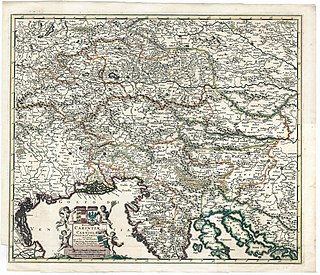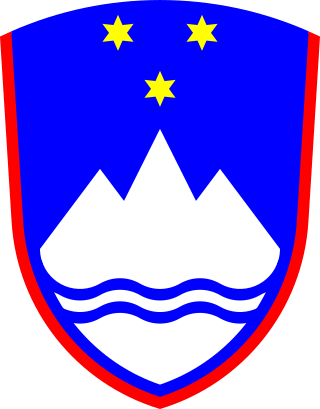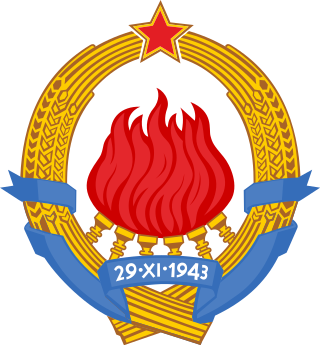
The history of Slovenia chronicles the period of the Slovenian territory from the 5th century BC to the present. In the Early Bronze Age, Proto-Illyrian tribes settled an area stretching from present-day Albania to the city of Trieste. The Slovenian territory was part of the Roman Empire, and it was devastated by the Migration Period's incursions during late Antiquity and the Early Middle Ages. The main route from the Pannonian plain to Italy ran through present-day Slovenia. Alpine Slavs, ancestors of modern-day Slovenians, settled the area in the late 6th Century AD. The Holy Roman Empire controlled the land for nearly 1,000 years, and between the mid-14th century and 1918 most of Slovenia was under Habsburg rule. In 1918, most Slovene territory became part of the Kingdom of Serbs, Croats, and Slovenes, and in 1929 the Drava Banovina was created within the Kingdom of Yugoslavia with its capital in Ljubljana, corresponding to Slovenian-majority territories within the state. The Socialist Republic of Slovenia was created in 1945 as part of federal Yugoslavia. Slovenia gained its independence from Yugoslavia in June 1991, and today it is a member of the European Union and NATO.

Yugoslavia was a country in Southeast and Central Europe that existed from 1918 to 1992.

The Slovene coat of arms is an emblem that consists of a red bordered blue shield on which there is a stylised white Mount Triglav, under which there are two wavy lines representing the sea and the rivers of the country. Above Mount Triglav, there are three golden six-pointed stars representing the Counts of Celje. It was designed in 1991 by Marko Pogačnik and adopted on 24 June 1991.

Styria, also Slovenian Styria or Lower Styria, is a traditional region in northeastern Slovenia, comprising the southern third of the former Duchy of Styria. The population of Styria in its historical boundaries amounts to around 705,000 inhabitants, or 34.5% of the population of Slovenia. The largest city is Maribor.

After a period of political and economic crisis in the 1980s, the constituent republics of the Socialist Federal Republic of Yugoslavia split apart, but the unresolved issues caused a series of inter-ethnic Yugoslav Wars. The wars primarily affected Bosnia and Herzegovina, neighbouring parts of Croatia and, some years later, Kosovo.

Pećinci is a village and municipality located in the Srem District of the autonomous province of Vojvodina, Serbia. The village has a population of 2,581 (2011), while Pećinci municipality has 19,720 inhabitants.

Anton Korošec was a Yugoslav politician, a prominent member of the conservative People's Party, a Roman Catholic priest and a noted orator.

The prime minister of Yugoslavia was the head of government of the Yugoslav state, from the creation of the Kingdom of Serbs, Croats and Slovenes in 1918 until the breakup of the Socialist Federal Republic of Yugoslavia in 1992.

The Socialist Republic of Serbia, previously known as the People's Republic of Serbia, commonly abbreviated as Republic of Serbia or simply Serbia, was one of the six constituent republics of the Socialist Federal Republic of Yugoslavia in what is now the modern day states of Serbia and the disputed territory of Kosovo. Its formation was initiated in 1941, and achieved in 1944–1946, when it was established as a federated republic within Yugoslavia. In that form, it lasted until the constitutional reforms from 1990 to 1992, when it was reconstituted, as the Republic of Serbia within the Federal Republic of Yugoslavia. It was the largest constituent republic of Yugoslavia, in terms of population and territory. Its capital, Belgrade, was also the federal capital of Yugoslavia.
The Constitution of Yugoslavia may refer to:

Teams from Yugoslavia first participated at the Olympic Games in 1920. Previously, several athletes from Croatia, Slovenia and northern Serbian province Vojvodina had competed for Austria or Hungary when those countries were part of the Empire of Austria-Hungary. A small team of two athletes had competed distinctly for Serbia at the 1912 Summer Olympics.

The Ministry of Foreign Affairs of Yugoslavia was the ministry responsible for representing the Kingdom of Yugoslavia internationally from 1918 to 1941 and the Socialist Federal Republic of Yugoslavia from 1945 to 1992. It may also refer to the ministry which represented Serbia and Montenegro from 1992 to 2006.

Yugoslavism, Yugoslavdom, or Yugoslav nationalism is an ideology supporting the notion that the South Slavs, namely the Bosniaks, Croats, Macedonians, Montenegrins, Serbs and Slovenes, but also Bulgarians, belong to a single Yugoslav nation separated by diverging historical circumstances, forms of speech, and religious divides. During the interwar period, Yugoslavism became predominant in, and then the official ideology of the Kingdom of Yugoslavia. There were two major forms of Yugoslavism in the period: the regime favoured integral Yugoslavism promoting unitarism, centralisation, and unification of the country's ethnic groups into a single Yugoslav nation, by coercion if necessary. The approach was also applied to languages spoken in the Kingdom. The main alternative was federalist Yugoslavism which advocated the autonomy of the historical lands in the form of a federation and gradual unification without outside pressure. Both agreed on the concept of National Oneness developed as an expression of the strategic alliance of South Slavs in Austria-Hungary in the early 20th century. The concept was meant as a notion that the South Slavs belong to a single "race", were of "one blood", and had shared language. It was considered neutral regarding the choice of centralism or federalism.

The flag of Yugoslavia was the official flag of the Yugoslav state from 1918 to 1992. The flag's design and symbolism are derived from the Pan-Slavic movement, which ultimately led to the unification of the South Slavs and the creation of a united south-Slavic state in 1918.

The emblem of Yugoslavia featured six torches, surrounded by wheat with a red star at its top, and burning together in one flame; this represented the brotherhood and unity of the six federal republics forming Yugoslavia: Bosnia and Herzegovina, Croatia, Macedonia, Montenegro, Serbia and Slovenia. The date imprinted was 29 November 1943, the day the Anti-Fascist Council for the National Liberation of Yugoslavia (AVNOJ) met in Jajce on its second meeting and formed the basis for post-war organisation of the country, establishing a federal republic. This day was celebrated as Republic Day after the establishment of the republic. The emblem of Yugoslavia, along with those of its constituent republics, are an example of socialist heraldry.
The Austro-Slovene conflict in Carinthia was a military engagement that ensued in the aftermath of World War I between forces loyal to the State of Slovenes, Croats and Serbs and later the Kingdom of Serbs, Croats and Slovenes, and forces loyal to the Republic of German-Austria. The main theater of the conflict was the linguistically mixed region in southeastern Carinthia. The conflict was settled by the Treaty of Saint-Germain in 1919, which stipulated that the territorial dispute be resolved by a plebiscite.

Austria–Yugoslavia relations were historical foreign relations between Austria and now broken up Yugoslavia. Both countries were created following the dissolution of Austria-Hungary in 1918. First Austrian Republic was a successor state of the empire while Yugoslavia was created after the unification of pre-World War I Kingdom of Serbia with the State of Slovenes, Croats and Serbs. In the days before this unification Kingdom of Serbia merged with the Banat, Bačka and Baranja and the Kingdom of Montenegro. During the interwar period of European history relations between the First Austrian Republic and the Kingdom of Yugoslavia were marked by the Austro-Slovene conflict in Carinthia, 1920 Carinthian plebiscite, 1920 establishment of pro-status quo Little Entente, 1934 Rome Protocols between revanchist Austria, Hungary and Fascist Italy and 1938 Anschluss.

Albania–Yugoslavia relations were historical foreign relations between Albania and now broken up Yugoslavia. With occasional periods of friendly relations or efforts to improve relations, the two countries predominantly maintained cold or openly hostile relations. The period of close relations developed right after the end of World War II when Yugoslavia pushed for socioeconomic integration of Albania into Yugoslavia within the Balkan Federation, but they turned into sharp antagonism after the 1948 Tito–Stalin split.














